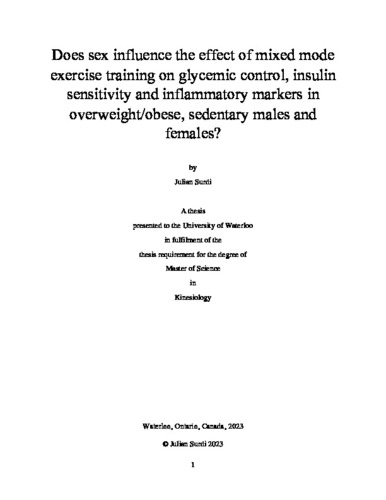| dc.description.abstract | Introduction: Type 2 diabetes mellitus (T2D) is prevalent within Canada, with a prediction of 5 million people living with this condition by 2025. Exercise reduces the risk of T2D by improving insulin sensitivity. However, recent trials have suggested that exercise training may be less efficacious at improving insulin sensitivity in females compared with males, which could have implications for the prevention and management of T2D in females. The purpose of this research was to examine whether sex influenced the effectiveness of mixed-mode training on glycemic control, insulin sensitivity and inflammation in overweight/obese individuals. Methods: Twenty-seven overweight/obese, sedentary males (n=12) and females (n=15) were recruited for a 12-week mixed-mode, exercise intervention. Prior to training, participants underwent anthropometric, aerobic fitness (V̇O2max test), strength (3-5 RM test) and oral glucose tolerance test (OGTT) assessments. Training consisted of 3 weekly sessions involving 30 minutes of aerobic and 30 minutes of resistance training. Results: There was no sex difference in glucose AUC (p=0.22, ηp2=0.03) or Cmax (p=0.14, ηp2=0.03); however, when adjusted for the glucose dose relative to LBM, males had a higher glucose AUC (p=0.002, ηp2=0.18) and Cmax (p=0.001, ηp2=0.19) than females. TNF-α, (p=0.04, ηp2=0.13) and MIP-1β (p=0.006, ηp2=0.20) were higher in males than females. There was no effect of training on glycemic control, insulin resistance/sensitivity indices, pancreatic β-cell function or inflammatory markers. However, the absolute change in glucose AUC (males: -99.8 mmol/L·120min, females +58.3 mmol/L·120min, p=0.01, d=1.06), Cmax (males: -0.60 mmol/L, females +0.7 mmol/L, p=0.04, d=0.87) and IL-1ra (males: -18.2 pg/mL, females +28.9 pg/mL, p=0.02, d=1.20) differed between the sexes. . Conclusion: Changes in glycemic control and inflammation following training differed between males and females. A sex difference was seen in inflammatory markers; however, further research is required. Finally, females had lower glucose AUC and Cmax relative to LBM compared to males, which questions the use of a standard 75g glucose dose during an OGTT as a measure of impaired glucose tolerance. | en |

